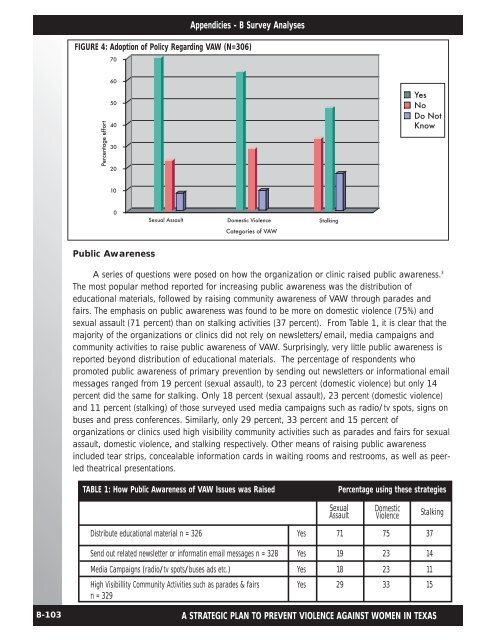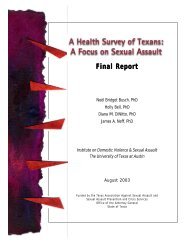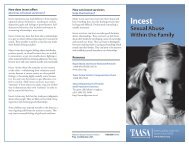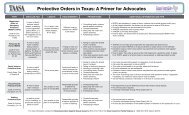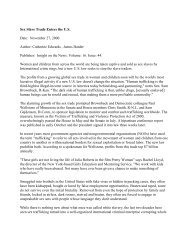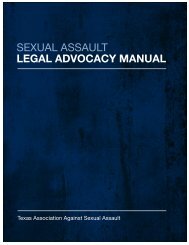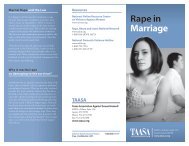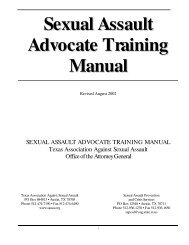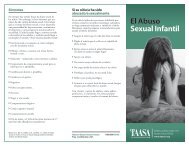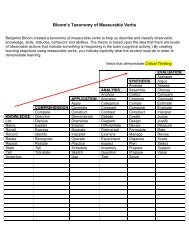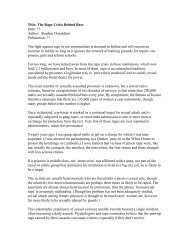TDH Booklet4 - Texas Association Against Sexual Assault
TDH Booklet4 - Texas Association Against Sexual Assault
TDH Booklet4 - Texas Association Against Sexual Assault
Create successful ePaper yourself
Turn your PDF publications into a flip-book with our unique Google optimized e-Paper software.
Appendicies - B Survey Analyses<br />
FIGURE 4: Adoption of Policy Regarding VAW (N=306)<br />
70<br />
60<br />
Percentage effort<br />
50<br />
40<br />
30<br />
20<br />
Yes<br />
No<br />
Do Not<br />
Know<br />
10<br />
0<br />
<strong>Sexual</strong> <strong>Assault</strong> Domestic Violence Stalking<br />
Categories of VAW<br />
Public Awareness<br />
A series of questions were posed on how the organization or clinic raised public awareness. 3<br />
The most popular method reported for increasing public awareness was the distribution of<br />
educational materials, followed by raising community awareness of VAW through parades and<br />
fairs. The emphasis on public awareness was found to be more on domestic violence (75%) and<br />
sexual assault (71 percent) than on stalking activities (37 percent). From Table 1, it is clear that the<br />
majority of the organizations or clinics did not rely on newsletters/email, media campaigns and<br />
community activities to raise public awareness of VAW. Surprisingly, very little public awareness is<br />
reported beyond distribution of educational materials. The percentage of respondents who<br />
promoted public awareness of primary prevention by sending out newsletters or informational email<br />
messages ranged from 19 percent (sexual assault), to 23 percent (domestic violence) but only 14<br />
percent did the same for stalking. Only 18 percent (sexual assault), 23 percent (domestic violence)<br />
and 11 percent (stalking) of those surveyed used media campaigns such as radio/tv spots, signs on<br />
buses and press conferences. Similarly, only 29 percent, 33 percent and 15 percent of<br />
organizations or clinics used high visibility community activities such as parades and fairs for sexual<br />
assault, domestic violence, and stalking respectively. Other means of raising public awareness<br />
included tear strips, concealable information cards in waiting rooms and restrooms, as well as peerled<br />
theatrical presentations.<br />
TABLE 1: How Public Awareness of VAW Issues was Raised<br />
Percentage using these strategies<br />
<strong>Sexual</strong><br />
<strong>Assault</strong><br />
Domestic<br />
Violence<br />
Stalking<br />
Distribute educational material n = 326 Yes 71 75 37<br />
Send out related newsletter or informatin email messages n = 328 Yes 19 23 14<br />
Media Campaigns (radio/tv spots/buses ads etc.) Yes 18 23 11<br />
High Visibillity Community Activities such as parades & fairs Yes 29 33 15<br />
n = 329<br />
B-103 A STRATEGIC PLAN TO PREVENT VIOLENCE AGAINST WOMEN IN TEXAS


